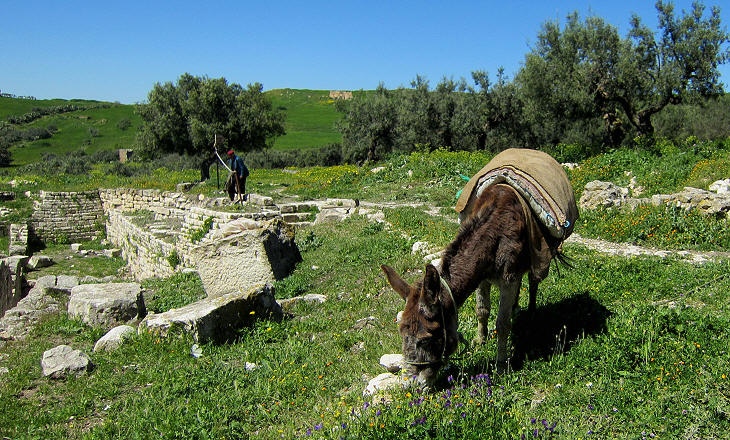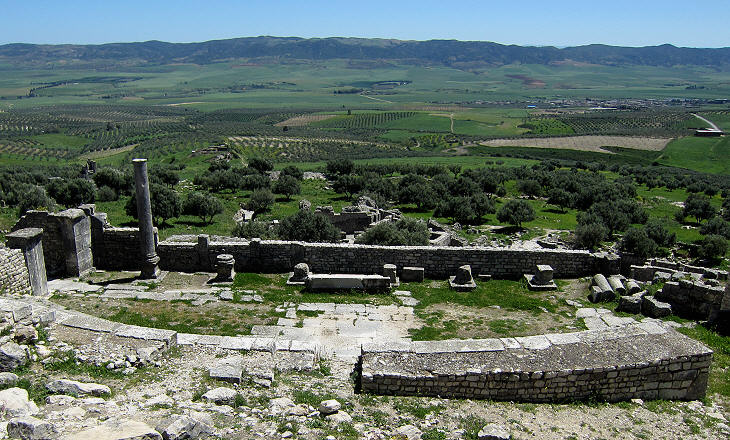  What's New! Detailed Sitemap All images © by Roberto Piperno, owner of the domain. Write to romapip@quipo.it. Text edited by Rosamie Moore. Page added in July 2012. |
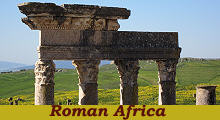 - Thugga (Dougga) - Thugga (Dougga)(detail of the theatre at Thugga) Among the excursions from Tunis, that to Dougga, where the French archaeologists have been excavating, is much to be recommended. The theatre there is a perfect one. It is even in a better state of preservation than the Theatre of Dionysos at Athens. The Temple of Jupiter, Juno, and Minerva is one of the gems of architecture in the whole of Tunisia. It is wonderfully perfect. There are also the Temples of Saturn and Caelestes, whose outlines the French have exposed. At Dougga there is also the Libyo-Punic monument from which Sir Thomas Reade removed the bi-lingual stone which is now in the British Museum. Apart from the antiquities, the picturesqueness of the country would claim for it a visit. (1895 Murray's Handbook for travellers in Algeria and Tunisia).
Thugga was situated in the southern side of the Bagradas (today Mejerda) River valley in today's northern Tunisia. The river had its source in the Atlas Mountains at a height of more than 3,000 ft. During Roman rule, thanks to a complex system of irrigation, the valley became a granary which provided key supplies to Rome. Thugga and many other Numidian settlements became small prosperous towns with temples, baths, theatres and other public facilities.
After the fall of the Roman Empire the stones of many ancient monuments and houses were used to build Arab towns which in some instances, such as at Sicca Veneria/El-Kef, stood on the same site as the old Roman town or at a short distance from it. Thugga instead returned to being a small village of farmers who did not need to use the ancient buildings as a quarry and who regarded the remaining standing monuments as part of their heritage. Today the ruins of Thugga are included in an archaeological area, but farming activities continue to be carried on in its peripheral sections, something which helps in understanding the environment of the ancient town (for another similar archaeological site in a rural context see a page on A Forgotten Roman Town in Asia Minor).
In 1628 Thomas d'Arcos, a former secretary of Cardinal François de Joyeuse was captured by corsairs and sold at the slave market of Tunis. He was freed in 1630, but he preferred to remain in Tunis and he converted to Islam. He remained in touch with many correspondents in Europe, including Cardinal Antonio Barberini, brother of Pope Urban VIII, and in 1631 he reported having visited a village where the portico of a Roman temple stood in pristine condition and where he saw a very unusual mausoleum with a bilingual inscription. Other travellers visited the site and reported other details about the mausoleum and its inscription. In 1842 Sir Thomas Reade, the British consul in Tunis, commissioned the removal of the inscription to send it to the British Museum (it opens in a separate window). The operation was made in such a maladroit way that the two upper storeys of the building collapsed. The mausoleum is located in the valley below the town, so maybe one should say that it is at Thugga, but not a monument of Thugga, because assuming the inhabitants of the small town wanted to celebrate a fellow citizen they would have built the mausoleum at its top.
The monument is dated IInd century BC and the personage for whom it was built is still unknown. It is aka Mausoleum of Ataban after the name of its architect. Elements of the decoration such as the chariots and the lion suggest that it was made for a great military leader and the first name which comes to mind is that of Massinissa, King of Numidia, an ally of the Romans during the Third Punic War. The design of the mausoleum is vaguely similar to a monument at Sabratha in today's Libya.
In 105 BC the Romans defeated Jugurtha, grandson of Massinissa, after a long war and Thugga was included in the province of Africa. Land in the Mejerda River valley was distributed to veterans and in 30 BC Legio III Augusta was permanently stationed in Africa. Thugga retains few traces of the early Roman rule; its main monuments date IInd and IIIrd century AD. The Capitolium was a temple dedicated to Jupiter, Juno and Minerva, the three gods who were worshipped in a great temple on the Capitolium hill in Rome. It was built at the centre of the Forum to celebrate the concession of Roman citizenship to the inhabitants of the town by Emperors Marcus Aurelius and Lucius Verus, so it was more of a civil building than a place of worship. The ceremonies which took place in this temple were linked to lay festivities, such as the foundation of Rome on April 21st and public announcements were made from its steps.
Roman emperors were deified after their death and so the relief on the tympanum portrayed Antoninus Pius, the predecessor of Marcus Aurelius and Lucius Verus. The deification was symbolized by an eagle carrying the emperor to Heaven (see the relief on the Arch of Titus in Rome), however while at Thugga they used the traditional iconography, in Rome the apotheosis of Antoninus was depicted in a more elaborate way.
In general archaeologists have not found in Tunisia as many statues as they expected considering the wealth of the country during Roman rule. Likely causes have been identified as the absence of a local school of sculpture and the iconoclastic fury of Byzantines and Muslims. The wall with the niches for the statues of the gods is not a modern reconstruction, but together with the portico and the portal bearing the celebratory inscription, is the original part of the building which so impressed the first visitors to Thugga.
The concession of Roman citizenship to the inhabitants of Thugga was limited to those of civitas, the town and did not extend to those of pagus, the countryside district around Thugga, because the inhabitants of the latter had it already as they were descendants of Roman veterans. Civitas and pagus were two separate bodies. There were differences in legislation and taxation which ended in 205 when Emperor Septimius Severus fused civitas and pagus into a municipium having jurisdiction over both the town and the surrounding rural district.
For the ancient Romans pietas was a mixture of affection and compassion among human beings. It was symbolized by a crane. Many coins of the time of Emperor Hadrian had an inscription with the words Pietas Augusti on the back. Antoninus was given the epithet Pius with reference to this civic virtue he had promoted throughout his life. The small temple of Pietas Augusti at Thugga was built at the time of Emperor Hadrian according to a (lost) inscription quoted by Thomas d'Arcos in his letters. The temple is located on the street leading to the Forum.
In 1908-10 French archaeologists excavated the area near the Forum and they unearthed a paved square having a decoration with the names of sixteen winds. The square linked the Forum to a marketplace of which only the foundations remain. A Temple to Mercury, god of trade, stood on the northern side of the square, close to the Capitolium. The eastern side of the square had the shape of a crescent with steps where the inhabitants of Thugga sat to chat, play and bet (you can see small cavities similar to those at Thugga in a page dealing with Philippi in Greece).
Tunisia is famous for the number and quality of its Roman mosaics. These were usually found in large houses away from the centre of towns and more often in villas in the countryside. At Thugga instead archaeologists found an elaborate mosaic near Wind Rose Square. It was probably located in the dining room of the building and it was meant to invite guests to enjoy their meal and in particular the wine. It portrays two giant slaves pouring wine to guests from large amphorae. The Greek word PIE (drink!) is written on the right amphora to which the left amphora replies ZHCHC (and you will live!). Two servants at the sides of the giants bring flowers, a napkin and a vase with perfume. The words are Greek, but they were written in the Latin alphabet. Very few non-Latin inscriptions have been found at Thugga and in nearby towns; the language spoken by the natives was only oral and probably they never had an in-depth knowledge of the Punic alphabet, which continued to be used in some big cities such as Leptis Magna.
The construction of many temples and public buildings at Thugga was due to donations by the Gabinii, a local wealthy family. Their generosity facilitated accession to public offices which granted prestige and probably some indirect economic benefits. The dedication to Concordia, Frugifer (the fruit-bearer, a synonym for Abundance) and Liber Pater (Dionysus/Bacchus) is an example of syncretism, the combining of different beliefs. Archaeologists found that the temples housed statues portraying the donors in addition to those of the deities.
The Gabinii built a sort of small theatre next to the Temple to Liber Pater, which was probably used for ceremonies associated with the cult of Dionysus, the Greek god of winemaking, and in particular with initiation rites. Thugga was built on the slope of a terraced hill and it did not have the usual orthogonal grid of streets of Roman towns. It was linked by two short roads to the main road built by the Romans in the valley south of the town to link Carthage to Theveste, in today's Algeria, where Legio Augusta III was stationed.
Thugga had a theatre built at the time of Emperor Augustus by excavating the hill at the top of the town. It was entirely rebuilt at the same time as the Capitolium. It has been restored in order to allow safe performances during the Festival of Dougga, but it is not dramatically unlike the photos taken in the early phases of the archaeological excavations. It could seat an audience of 3,500 (the population of Thugga has been estimated in the range of 5-10,000).
The design of Roman theatres during the period from Augustus to Emperor Alexander Severus is extremely consistent with only minor changes. You may wish to compare the theatre of Thugga with those at Sabratha, Miletus and Bosra. In the long inscription the donor stated that he built theatrum cum basilicis et porticu et xystis (gardens) et scaena cum siparis (curtains) et ornamentis om[ni]bus with his own money. The donor was not the first one to spell out all the details of what he had done for the community: Emperor Augustus in his Index Rerum Gestarum, a list of what he had done for the Romans, did not hesitate to say exactly how many sesterces (Roman coins which were used as unit of account) he spent.
The "Golden Century" of Thugga can be set between the reigns of Emperors Hadrian (117-138) and Alexander Severus (222-235). Arches, baths, temples were built in addition to those illustrated in this page. Then something happened which led to the decline of Thugga in the early IVth century. In most of the other towns of the region there are monuments, usually churches, of the following centuries, but not at Thugga, apart from St. Victoria's, a poorly built church. The image used as background for this page shows one of the few reliefs which were found in the town. It portrays a man holding a cornucopia. Move to page two: north-western quarters of the town or page three: south-eastern quarters Move to: Introductory Page Bulla Regia Carthago Mactaris Musti Neapolis Sicca Veneria Simitthus Sufetula Thuburbo Majus Thysdrus Uthina Utica Ziqua Mosaics in the Museum of Bardo  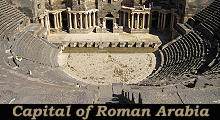  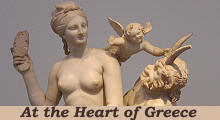
|

